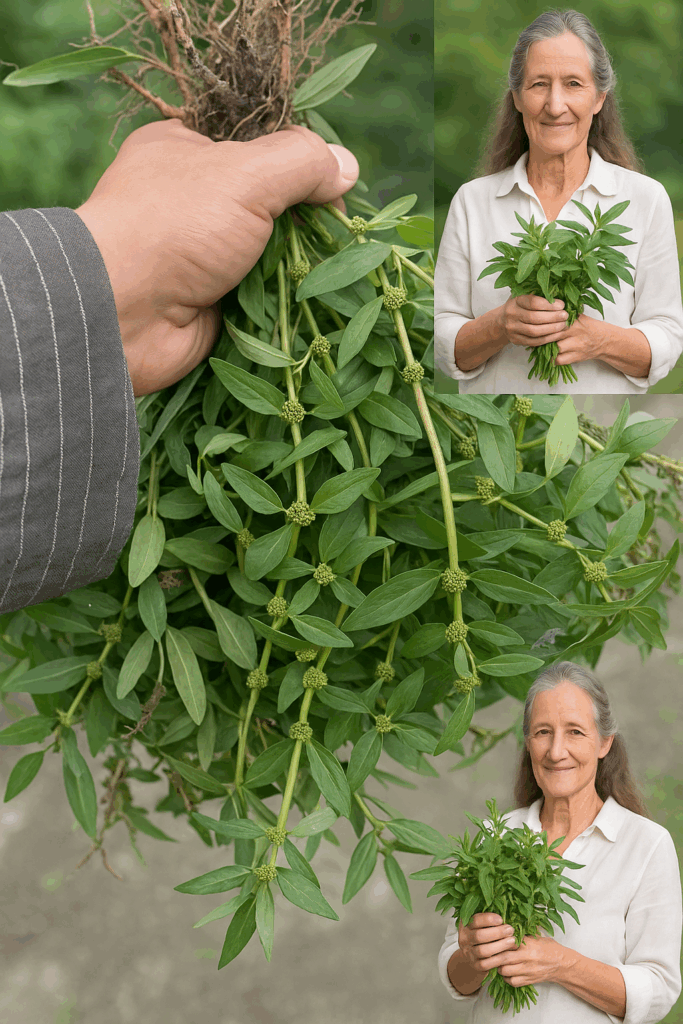Imagine a humble plant, often mistaken for a weed, that holds the power to soothe asthma, heal wounds, and boost your immunity—all growing wild in fields and roadsides. Euphorbia hirta, commonly known as asthma weed, snakeweed, or tawa-tawa, is a medicinal marvel revered in traditional healing systems across tropical and subtropical regions. Packed with bioactive compounds like flavonoids, tannins, and alkaloids, this herb offers a treasure trove of health benefits, from relieving respiratory issues to combating skin infections. However, its potent properties demand careful use to avoid toxicity. This expert guide unveils 30 science-backed benefits of Euphorbia hirta, practical ways to use it at home, and essential safety tips to harness its healing potential responsibly.

Why Euphorbia Hirta Stands Out
🌿 Euphorbia hirta thrives in warm climates, its small, hairy leaves and delicate flowers hiding a powerhouse of therapeutic compounds. Used for centuries in Ayurveda, Traditional Chinese Medicine, and folk remedies, this plant is a natural pharmacy for ailments ranging from coughs to joint pain. Its accessibility makes it a sustainable, cost-free resource for those who forage or cultivate it. Yet, its potency requires respect—proper preparation and moderation are key to unlocking its benefits safely. Whether you’re a herbal enthusiast or new to natural remedies, Euphorbia hirta offers a world of wellness waiting to be explored.
30 Health Benefits of Euphorbia Hirta
1. Supports Respiratory Health
🌬️ Known as asthma weed, its bronchodilatory effects ease breathing difficulties in asthma and bronchitis, reducing airway inflammation.
2. Soothes Coughs
🤧 The expectorant properties help clear mucus, relieving dry or persistent coughs and soothing throat irritation.
3. Eases Bronchitis Symptoms
💨 Anti-inflammatory compounds reduce bronchial swelling, improving airflow and comfort during respiratory infections.
4. Enhances Digestion
🍽️ Bitter compounds stimulate digestive enzymes, alleviating indigestion, bloating, and gas.
5. Relieves Diarrhea
🚽️ Antimicrobial and astringent properties help control loose stools, restoring gut balance in mild cases.
6. Treats Dysentery
🩺 Its antibacterial action targets pathogens causing dysentery, supporting recovery when used under guidance.
7. Protects Stomach Ulcers
🩹 Compounds like flavonoids may shield the stomach lining, promoting healing of ulcers and reducing discomfort.
8. Reduces Fever
🌡️ Traditionally used as a cooling herb, it lowers body temperature during fevers when applied as a compress or consumed as tea.
9. Boosts Immunity
💪 Rich in vitamin C and antioxidants, it strengthens immune defenses, helping prevent infections.
10. Promotes Skin Healing
✨ A poultice of crushed leaves accelerates wound closure and reduces swelling in minor cuts and bruises.
11. Fights Skin Infections
🛡️ Antibacterial and antifungal properties combat fungal infections like ringworm and bacterial skin issues.
12. Reduces Acne
🌟 Diluted leaf extract calms inflammation and controls oil production, minimizing acne flare-ups.
13. Manages Eczema
🧴 Topical use soothes itching and redness, offering relief for eczema and other skin irritations.
14. Controls Dandruff
💆♀️ A herbal rinse reduces scalp flaking and itching, promoting a healthier scalp.
15. Eases Menstrual Cramps
🌸 Muscle-relaxant properties relieve menstrual pain and discomfort when consumed as tea.
16. Balances Hormones
⚖️ Preliminary studies suggest it may regulate hormonal imbalances, supporting reproductive health.
17. Enhances Lactation
🤱 Traditionally used to boost milk production in nursing mothers, but only under expert supervision.
18. Treats Urinary Tract Infections (UTIs)
🚰 Diuretic effects flush out bacteria, aiding UTI recovery when used in small, controlled doses.

19. Combats Parasites
🦠 Antiparasitic compounds help expel intestinal worms, but professional guidance is essential.
20. Reduces Anxiety
🧘 Mild sedative effects calm the nervous system, easing stress and promoting relaxation.
21. Supports Heart Health
❤️ Improved circulation and potential cholesterol-lowering effects contribute to cardiovascular wellness.
22. Manages Diabetes
🩺 Some studies indicate it may enhance insulin sensitivity, helping regulate blood sugar levels.
23. Relieves Joint Pain
🦴 Anti-inflammatory poultices reduce swelling and pain in arthritic joints or muscle soreness.
24. Soothes Toothaches
🦷 Leaf juice or chewed leaves provide temporary numbing relief for tooth pain.
25. Heals Mouth Ulcers
😷 A diluted decoction as a mouth rinse soothes ulcers and reduces oral inflammation.
26. Improves Eye Health
👁️ Diluted leaf juice, used as an eyewash, treats mild infections like conjunctivitis (under expert guidance).
27. Speeds Wound Healing
🩹 Antimicrobial properties prevent infection and promote faster recovery in minor wounds.
28. Reduces Inflammation
💥 Flavonoids and tannins combat systemic inflammation, benefiting conditions like arthritis.
29. Enhances Blood Circulation
🩺 Improved blood flow may reduce the risk of clots and support overall vitality.
30. Aids Detoxification
🧹 Acts as a mild detox agent, supporting liver and kidney function to eliminate toxins.
How to Use Euphorbia Hirta Safely
🍃 Euphorbia hirta can be prepared in various forms, but precise dosing and careful handling are crucial due to its potential toxicity. Always source from clean, pesticide-free areas and consult a herbalist or healthcare provider before use.
1. Herbal Tea
🍵 Boil 1-2 g (about 1 tsp) dried leaves or stems in 1 cup water for 5-10 minutes. Strain and drink 1 cup daily, no more than twice, to support respiratory, digestive, or menstrual health. Sweeten with honey to mask bitterness.
2. Topical Poultice
🧴 Crush fresh leaves into a paste and apply to wounds, acne, or inflamed skin. Cover with a clean cloth and leave for 15-20 minutes, then rinse. Use 1-2 times daily for minor issues.
3. Warm Compress
🩹 Soak a cloth in a warm decoction (1 tbsp dried herb in 2 cups water, boiled and cooled slightly) and apply to swollen joints or sore areas for 10-15 minutes to reduce pain and inflammation.
4. Herbal Rinse
🚿 Boil 5 g dried leaves in 1 liter water, cool, and strain. Use as a scalp rinse for dandruff or a mouth rinse for ulcers, 1-2 times daily.
5. Diluted Eyewash
👁️ Prepare a weak tea (0.5 g herb in 1 cup water), cool, and strain thoroughly. Use as an eyewash for mild infections, but only under professional supervision to avoid irritation.
Sample Recipe: Euphorbia Hirta Soothing Tea
🍵 This gentle tea supports respiratory health and digestion.
Ingredients:
- 1 tsp (1-2 g) dried Euphorbia hirta leaves or stems
- 1 cup boiling water
- 1 tsp honey (optional)
Instructions:
- Place dried herb in a cup.
- Pour boiling water over and steep for 5-10 minutes.
- Strain, add honey if desired, and sip slowly. Limit to 1 cup daily.
Potential Risks and Safety Precautions
⚠️ While Euphorbia hirta is a potent healer, its milky sap contains compounds like diterpenes that can be toxic in high doses or with improper use. Handle with care and follow these guidelines:
- Toxicity: Overuse may cause nausea, vomiting, diarrhea, or skin irritation. Stick to recommended doses (e.g., 1-2 g for tea, small amounts for topical use).
- Allergies: Test on a small skin patch before topical use, as some may experience irritation or allergic reactions.
- Contraindications: Avoid during pregnancy or breastfeeding, as it may stimulate uterine contractions or affect infants. Not suitable for children without expert approval.
- Medical Conditions: Consult a healthcare provider if you have liver, kidney, or heart issues, or are on medications like blood thinners or diabetes drugs, as interactions are possible.
- Proper Preparation: Always wash thoroughly and use gloves when handling fresh plants to avoid sap-related irritation. Ensure thorough straining for teas or rinses to remove plant debris.
- Foraging: Harvest from uncontaminated areas, avoiding roadsides or chemically treated zones. Misidentification with other Euphorbia species can be dangerous, so verify with a field guide or expert.
Why Euphorbia Hirta Shines
🌍 Euphorbia hirta is a testament to nature’s ability to pack profound healing into unassuming plants. Its wide-ranging benefits—spanning respiratory relief, skin care, and detoxification—make it a versatile addition to any herbal repertoire. Unlike synthetic remedies, it’s sustainable and often free to forage, empowering you to take charge of your health naturally. Rooted in centuries of traditional wisdom and supported by emerging research, this herb bridges ancient healing with modern wellness. By using it responsibly, you can tap into a legacy of natural medicine that’s as potent as it is accessible.
Start Your Euphorbia Hirta Journey
Don’t overlook this remarkable herb hiding in plain sight. Brew a soothing tea, craft a healing poultice, or explore its topical benefits, and discover the transformative power of Euphorbia hirta. Share its potential with loved ones, but always prioritize safety by consulting a healthcare professional. Begin your journey today, and let this “weed” redefine your approach to natural healing with its extraordinary benefits.
Disclaimer: This information is for educational purposes only and not intended to diagnose, treat, or cure any condition. Euphorbia hirta can be toxic if misused. Always consult a qualified healthcare professional or herbalist before use, especially if pregnant, breastfeeding, or managing health conditions. Use responsibly to avoid adverse effects.


